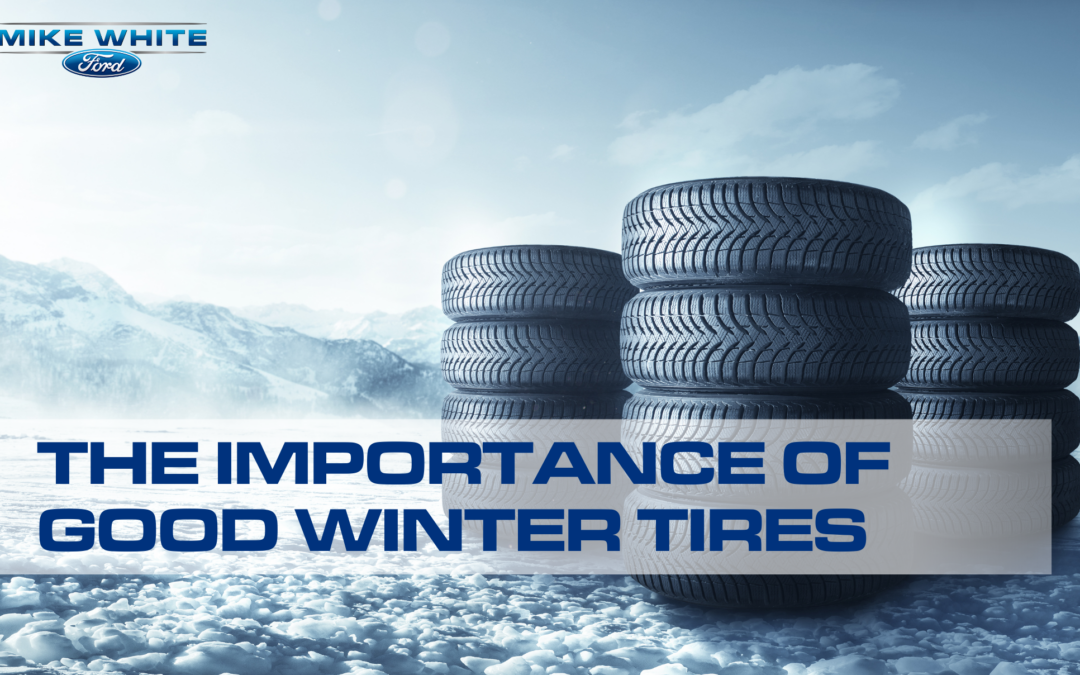At Mike White Ford, we understand that living in northern Idaho comes with unique driving challenges, especially during the winter. The mountainous terrain, heavy snowfall, black ice, freezing rain, and blowing and drifting snow can instantly change road conditions, making safe driving a daunting task. That’s why we recommend equipping your vehicle with good winter tires.
The Problem with Inadequate Tires
Driving without the appropriate tires in these conditions can lead to a host of problems, foremost among them reduced traction. Although many people think “all-weather” tires are sufficient to get them through the season, this is not true in the conditions that regularly prevail here in northern Idaho. Frigid temperatures will cause the rubber on all-season tires to harden, which means they lose the ability to grip the road. This loss of traction can make it difficult to accelerate, turn, and, most critically, brake. Having tires that can handle the temperature and the terrain is not a luxury, it’s a necessity if you want to protect yourself, your passengers, and other users of the road.
Advantages
Winter tires are specifically designed to overcome these challenges. Here are some of the features you will find in good winter tires:
- Increased Flexibility: Winter tires are constructed with a rubber compound that remains flexible even in frigid temperatures. This flexibility allows the tires to maintain better contact with the road, improving grip and control.
- Exceptional Traction: The unique tread designs of winter tires are engineered to push snow outward, preventing snow buildup on the tire and enhancing traction. While an all-wheel or four-wheel drivetrain is clearly helpful for winter survival, that is not enough. Winter tires provide a critical advantage. And if you don’t have four-wheel drive capability, good winter tires make a significant difference in the safety and handling of your two-wheel drive vehicle.
- Enhanced Steering and Braking: The flexibility and softness of winter tires create better grip, diminishing the likelihood that your vehicle will slide when driving over icy, snowy, or wet roads. This improved control is particularly crucial when navigating steep mountain roads and roads the snow plows haven’t cleared – common driving conditions here in north Idaho.
- Reduced Hydroplaning: Winter tires are effective at preventing hydroplaning. In this dangerous situation, your tires lose contact with the road due to standing water. Their superior tread design helps channel water away, providing a safer driving experience even in wet weather.
When to Install Winter Tires
To make the most of winter tires and keep them in good condition for several seasons, people typically install them in mid-November and remove them in mid-March or whenever the snow has almost completely disappeared. In northern Idaho, however, weather can be unpredictable. If you need new winter tires, purchase them when they become available in the fall and schedule your installation ahead of time, as there is often a rush when the first snow falls.
Cost Over Time
Are you concerned about the cost of winter tires? It’s true that winter tires can be more costly, but don’t compromise on safety. If you are having trouble convincing yourself to invest in winter tires, consider this: most people drive about 14,000 miles per year and tend to drive more in the summertime. If you use your winter tires 4 or 5 months out of the year, you will probably put about 4,000 to 6,000 miles on those tires every winter. If you get tires that have a 40,000-mile warranty, that means you may be able to get 8 or 9 seasons out of your winter tires. When you divide the cost of your tires over this period, you realize that the investment is well worth it when it comes to your and your family’s safety. After the initial investment, you will have peace of mind knowing that your tires will be there when you need them next winter.
Proper Storage is Key
To preserve their longevity, you should remove winter tires when warmer temperatures return. Because of the rubber compound used on winter tires, hot, dry pavement can wear them down quickly and shorten their life. When not in use, storing your winter tires properly in a cool, dry place such as a basement or a climate-controlled shop is crucial. High heat and high humidity can degrade the rubber.
Versatility
Winter tires are not limited to specific vehicle types. Whether you drive a truck, SUV, or a smaller vehicle, whether two-wheel, four-wheel, or all-wheel drive, winter tires can significantly improve your vehicle’s performance in winter conditions with respect to accelerating, turning, response time, and braking. There are winter tires for every vehicle.
At Mike White Ford, we take driving seriously, and safety is always a priority. If you need help finding the right winter tires for your vehicle or would like us to install your winter tires, call Mike White Ford today. Preparing your car or truck for the cold weather ahead will make your winter more enjoyable. Stay safe and enjoy the winter wonderland of northern Idaho with confidence!

